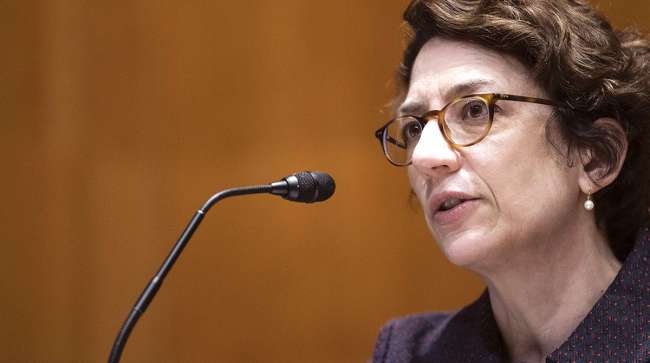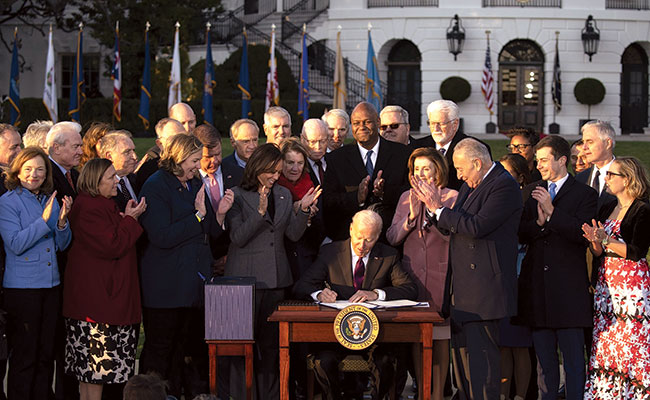Senior Reporter
Safety Will Guide Trucking Policies’ Implementation, Top USDOT Officials Say

[Stay on top of transportation news: Get TTNews in your inbox.]
WASHINGTON — Ensuring the safety of motorists on the country’s roadways is the primary focus of the U.S. Department of Transportation as it implements policies specific to trucking in a new infrastructure law, senior department officials said.
Deputy Transportation Secretary Polly Trottenberg, among the keynote speakers at this year’s Transportation Research Board’s annual meeting, recently told Transport Topics safety objectives will guide the implementation process.
The enactment of the $1 trillion Infrastructure Investment and Jobs Act in November tasked the department with pursuing the implementation of myriad freight and trucking provisions related to workforce recruitment and retention.
Specific to trucking policy, the new infrastructure law established an apprenticeship for commercial drivers younger than 21 to drive interstate, a women-in-trucking outreach program and a truck-leasing task force, among other provisions.
Such policies aim to enhance opportunities for truck drivers from multiple generations, as well as introduce trucking jobs to underrepresented groups in the industry. The pandemic, Trottenberg contended, amplified commercial drivers’ essential role along supply chains. American Trucking Associations estimated the industry is short about 80,000 truckers.
I want to emphasize, in particular for the apprenticeship program … that we’re doing it in a way that is safe.
Deputy Transportation Secretary Polly Trottenberg
Trottenberg said, “[USDOT’s aim is] looking for ways to bring new populations in.”
“I want to emphasize, in particular for the apprenticeship program, because as you know, there’s a lot of discussion about also the safety element; making sure that we’re doing it in a way that is safe,” she told TT on Jan. 10. “Our leadership at [the Federal Motor Carrier Safety Administration] has been engaging with all of the stakeholders on that.
“We want to bring new populations into this field but I always want to make sure we’re prioritizing safety, as well.”
The Infrastructure Investment and Jobs Act, enacted by President Joe Biden in November, formed an apprenticeship program under which drivers younger than 21 may qualify to drive commercial vehicles interstate. By law, under-21 commercial drivers were prohibited to operate interstate.

The Infrastructure Investment and Jobs Act, which President Joe Biden signed into law in November, includes a provision for the creation of an apprenticeship program under which drivers younger than 21 may qualify to drive commercial vehicles interstate. (Stefani Reynolds/Bloomberg News)
The apprenticeship consists of probationary periods, during which drivers may operate in interstate commerce with the supervision of an experienced driver in the passenger seat. An experienced driver must be 26 or older with a commercial driver license, have been employed for at least the past two years and have at least five years of interstate commercial motor vehicle experience.
The law also established the women of trucking advisory board to review and report on policies that educate, train and mentor women. The board is meant to encourage women to enter the field. A truck leasing advisory board was established to promote driver retention by facilitating access to resources meant to assist commercial drivers in assessing leasing agreements.
Trottenberg observed, “The big focus we have: We’re standing up a lot of different programs and just making sure that we’re well-organized, that we’re rolling those out and that particularly, again, that we’re working with our stakeholders.”

New year, new resilience. Host Mike Freeze and reporters Connor Wolf and Eugene Mulero uncover the lessons 2020 and 2021 taught trucking's business leaders and consider business and legislative solutions in the year ahead. Hear a snippet above, and get the full program by going to RoadSigns.TTNews.com.
Trottenberg reiterated her colleagues’ sentiment by thanking truckers’ contributions.
“The pandemic has underscored how incredibly vital their work is — vital for the supply chain, vital for making sure we got medical supplies, the food on our grocery shelves — all the things we need,” she said.
Secretary Pete Buttigieg, who also emphasized safety, pointed to potential benefits from the implementation of the infrastructure law.
“These investments are going to have a very real impact on our daily lives,” he said during his address at TRB’s meeting Jan. 12. “They’re going to help people save money on gas, save time on their commutes. They’re going to help more children take the bus to school without having to worry about being exposed to toxic fumes.
“They’re going to put people to work. They’re going to reconnect communities, and I believe they’re going to save lives.”
As part of the Biden administration’s trucking action plan, USDOT and the Department of Labor recently reaffirmed a commitment to implement workforce recruitment and retention programs over the coming years.
In a statement, Buttigieg noted, “In some parts of the trucking industry, 90% of drivers turn over each year. Making sure truck drivers are paid and treated fairly is the right thing to do, and it will help with both recruiting new drivers and keeping experienced drivers on the job.”
Want more news? Listen to today's daily briefing below or go here for more info:




